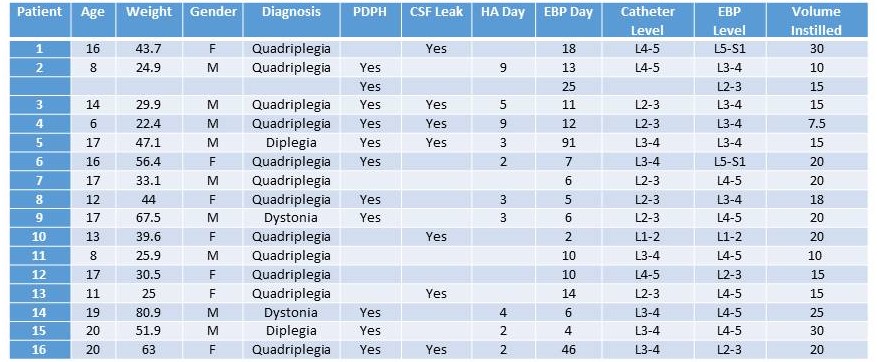PR1-154
Epidural Blood Patch for Post Dural Puncture Headache after Baclofen Pump Insertion
1Brenn B, 2Choudhry D, 2Sacks K
1Vanderbilt Children's Hospital, Nashville, Tennesee, USA; 2Alfren I duPont Hospital for Children, Wilmington, DE, USA
Introduction: Intrathecal drug delivery systems (IDDS) have proven efficacy in patients with intractable pain and spasticity (1). However, implantable pumps are not without complications. In addition to complications associated with medications infused, there are surgical complications such as hematoma formation, surgical infections, pump failure, catheter kinking or disconnection, and leakage of cerebrospinal fluid (CSF).
The incidence of post-dural puncture headaches (PDPH) associated with IDDS in was 22.9% in a recent report(2).
For the last two decades intrathecal baclofen delivered by implantable pump (ITBP) systems have become commonplace in children with intractable spasticity due to cerebral palsy (CP) (3). Reports of PDPH after implantation with a baclofen pump in the literature are few. In one review, only 0.6% (two patients of 316) reported a new headache in the postoperative period (4). Recently, our anesthesia pain service has been asked to perform several epidural blood patches on children with documented headache or CSF collections.
The purpose of this study was to review our institutions’ experience with PDPH after ITBP procedures and to compare our experience in this often non-verbal population.
Methods: After obtaining Institutional Review Board Approval, the records of all children who had a baclofen pump placement or replacement, or catheter replacement between 2008 and 2016 were extracted from our hospitals’ electronic medical record (Epic Systems, Verona WI).
This data was united with patient data from the Anesthesia Pain Service (APS) database on patients who had epidural blood patches placed.
A datasheet was constructed to record the following data elements: Name, medical record number, date of surgery, age, weight, diagnosis, presence of headache, headache onset, other symptoms, conservative therapies initiated, EBP performed, day when EBP was performed, level of EBP, volume of blood instilled, and any additional pertinent comments. Data was analyzed descriptively as there were no comparison groups.
Results: Data was returned on 313 surgical cases representing 242 patients, and yielded 47 cases (15%) of PDPH and/or documented CSF leak that were reviewed. 16 of these 47 patients (34%) underwent EBP. Details of the individual patients are presented in Table 1.
Discussion: The rate of PDPH in our CP population following ITBP was higher (15 vs. 0.6%) than previously reported, although lower than described after IDDS in adults (15 vs. 22.9%). This is likely due to difficulties in expressing HA symptoms in our population.
Conclusion: PDPH after ITBP is probably underreported. EBP can be used to treat PDPH and evidence of CSF leak.
References:
Belverud, S. et al. (2008). Neurotherapeutics 5(1): 114-122.
Bendel et al. (2016) Pain Res Treat.
Gilmartin, R. et al. (2000 J Child Neurol 15(2): 71-77
Borowski, A. et al. (2010). J Pediatr Orthop 30(1): 76-81.
Top












